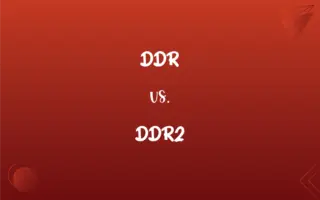Dislocation Creep vs. Diffusion Creep: What's the Difference?
Edited by Aimie Carlson || By Harlon Moss || Published on March 25, 2024
Dislocation creep involves the movement of dislocations through a crystal lattice, while diffusion creep involves atom migration through grain boundaries.

Key Differences
Dislocation creep is characterized by the movement and interaction of dislocations within the crystal structure of materials under stress, leading to permanent deformation. This process is highly dependent on temperature and applied stress, where the material's internal structure is altered as dislocations glide and climb through the lattice, creating a plastic deformation. Diffusion creep, on the other hand, involves the mass transport of atoms or vacancies through the material, typically along grain boundaries or through the lattice itself. This mechanism becomes significant at lower stresses and higher temperatures, where atoms can move more freely, allowing the material to deform by the gradual shifting of its constituent particles without the need for dislocations.
In dislocation creep, the rate of deformation is sensitive to the applied stress, following a power-law relationship, which indicates that even small increases in stress can lead to significantly faster deformation rates. The process is also influenced by the material's microstructure, such as grain size and orientation, which can impede or facilitate the movement of dislocations. Diffusion creep does not exhibit such a strong dependence on stress; instead, it follows a linear relationship with stress and is more influenced by temperature, as atomic mobility is essential for the diffusion process.
The mechanisms governing dislocation creep and diffusion creep lead to distinct microstructural signatures in deformed materials. Dislocation creep results in the formation of slip bands and cell structures within grains due to the accumulation and interaction of dislocations. Conversely, diffusion creep leads to a more uniform deformation with less pronounced microstructural features, as deformation occurs by the homogeneous flow of atoms across the material without the localized strain that dislocations produce.
Understanding the dominant deformation mechanism in a material is crucial for predicting its behavior under various conditions. Dislocation creep is more prevalent in metals and alloys at moderate temperatures and high stresses, where the material's strength and ductility are significantly affected by dislocation dynamics. Diffusion creep becomes dominant in high-temperature applications or in materials with very fine grain sizes, where atomic diffusion can readily accommodate applied stresses without the need for dislocation activity.
Comparison Chart
Deformation Mechanism
Movement of dislocations through the crystal lattice.
Atom migration through grain boundaries or lattice.
ADVERTISEMENT
Stress Dependence
Highly sensitive to stress, follows a power-law relationship.
Linear relationship with stress, less sensitive compared to dislocation creep.
Temperature Influence
Significant at lower temperatures relative to diffusion creep, but requires higher stress.
Becomes dominant at high temperatures, facilitating atomic mobility.
Microstructure Impact
Results in slip bands and cell structures within grains.
Leads to uniform deformation without pronounced microstructural features.
Material Examples
Common in metals and alloys under moderate temperatures and high stresses.
Observed in materials with fine grain sizes or at high temperatures.
Dislocation Creep and Diffusion Creep Definitions
Dislocation Creep
Stress-driven lattice distortion.
High-pressure conditions cause dislocation creep in earth's mantle rocks.
ADVERTISEMENT
Diffusion Creep
Deformation by atom migration.
Ceramic materials under prolonged heat exhibit diffusion creep.
Dislocation Creep
Grain structure alteration due to stress.
Forging steel alters its grain structure through dislocation creep.
Diffusion Creep
Grain boundary atom movement.
High-temperature exposure causes diffusion creep in polycrystalline materials.
Dislocation Creep
Temperature-sensitive deformation mechanism.
Jet engine components experience dislocation creep at elevated temperatures.
Diffusion Creep
Influenced by atomic mobility.
In superalloys, diffusion creep facilitates creep resistance at high temperatures.
Dislocation Creep
Plastic deformation through dislocation movement.
The bending of a metal beam under load demonstrates dislocation creep.
Diffusion Creep
Dominant at low stress, high temperature.
Nuclear reactor materials undergo diffusion creep due to intense heat.
Dislocation Creep
Dependent on material's crystal structure.
The crystal structure of aluminum makes it susceptible to dislocation creep.
Diffusion Creep
Uniform deformation process.
Diffusion creep in rocks leads to uniform geological formations.
FAQs
Under what conditions is dislocation creep most prevalent?
Dislocation creep dominates at moderate temperatures and high stresses where dislocation movement is facilitated.
Can both dislocation creep and diffusion creep occur in the same material?
Yes, both mechanisms can occur simultaneously or sequentially in a material, depending on the temperature, stress, and microstructural conditions.
How does diffusion creep differ from dislocation creep?
Diffusion creep involves the migration of atoms or vacancies, typically along grain boundaries or through the lattice, unlike the movement of dislocations in dislocation creep.
How does grain size affect dislocation creep and diffusion creep?
Smaller grain sizes can impede dislocation movement, affecting dislocation creep, while enhancing diffusion creep by providing more grain boundary area for atom migration.
How does diffusion creep affect material properties?
Diffusion creep can lead to uniform deformation, potentially altering mechanical properties such as hardness and ductility.
Is dislocation creep reversible?
Dislocation creep results in permanent, plastic deformation and is not reversible.
What is dislocation creep?
Dislocation creep is the deformation of materials through the movement of dislocations within the crystal lattice under stress.
What factors influence diffusion creep?
Diffusion creep is influenced by temperature and the atomic mobility within the material, and is less dependent on applied stress.
What role does temperature play in diffusion creep?
Temperature plays a critical role in diffusion creep by increasing atomic mobility, thereby facilitating the migration of atoms across or along grain boundaries.
Are there specific materials more susceptible to dislocation creep?
Metals and alloys are particularly susceptible to dislocation creep, especially at temperatures that are high relative to their melting point.
How is the stress dependence different between dislocation creep and diffusion creep?
Dislocation creep has a strong, nonlinear dependence on stress, whereas diffusion creep shows a more linear, less sensitive relationship with stress.
How do environmental factors affect diffusion creep?
Environmental factors such as temperature and atmospheric composition can significantly influence the rate of diffusion creep.
What are the microstructural signs of dislocation creep?
Signs include slip bands, cell structures, and dislocation pile-ups within grains.
Can diffusion creep occur in single crystals?
While less common, diffusion creep can occur in single crystals, primarily through lattice diffusion.
Can dislocation creep lead to material failure?
Yes, extensive dislocation creep can lead to material failure, especially under cyclic loading conditions.
Is dislocation creep a concern in microelectronics?
Yes, dislocation creep can affect the reliability of microelectronic components, particularly at elevated temperatures.
How do researchers study diffusion creep?
Researchers use techniques like transmission electron microscopy (TEM) and atom probe tomography (APT) to study diffusion creep at the atomic level.
How does the presence of impurities affect diffusion creep?
Impurities can either enhance or inhibit diffusion creep, depending on their interaction with the host material's atomic structure.
What is the impact of alloying elements on dislocation creep?
Alloying elements can strengthen the material, hindering dislocation movement and thus affecting dislocation creep.
What advancements have been made in controlling dislocation creep?
Advancements include the development of high-temperature alloys and ceramic matrix composites designed to resist dislocation creep.
About Author
Written by
Harlon MossHarlon is a seasoned quality moderator and accomplished content writer for Difference Wiki. An alumnus of the prestigious University of California, he earned his degree in Computer Science. Leveraging his academic background, Harlon brings a meticulous and informed perspective to his work, ensuring content accuracy and excellence.
Edited by
Aimie CarlsonAimie Carlson, holding a master's degree in English literature, is a fervent English language enthusiast. She lends her writing talents to Difference Wiki, a prominent website that specializes in comparisons, offering readers insightful analyses that both captivate and inform.































































